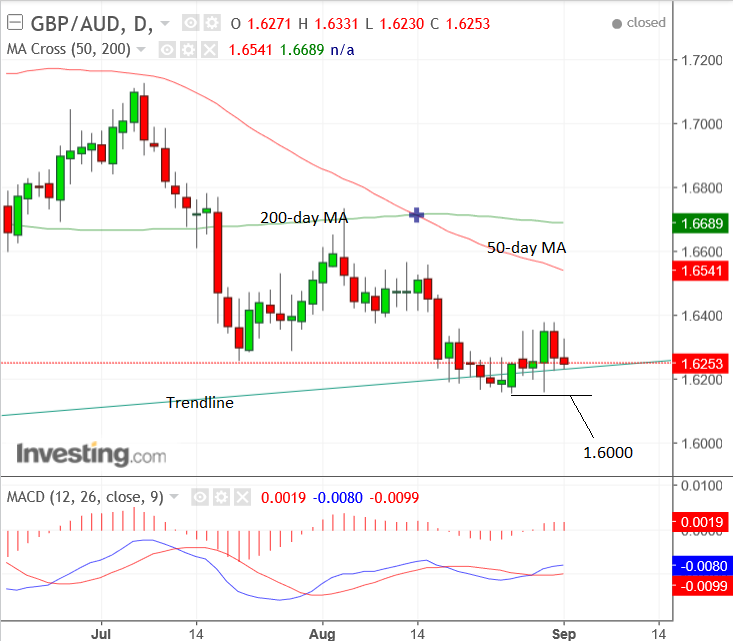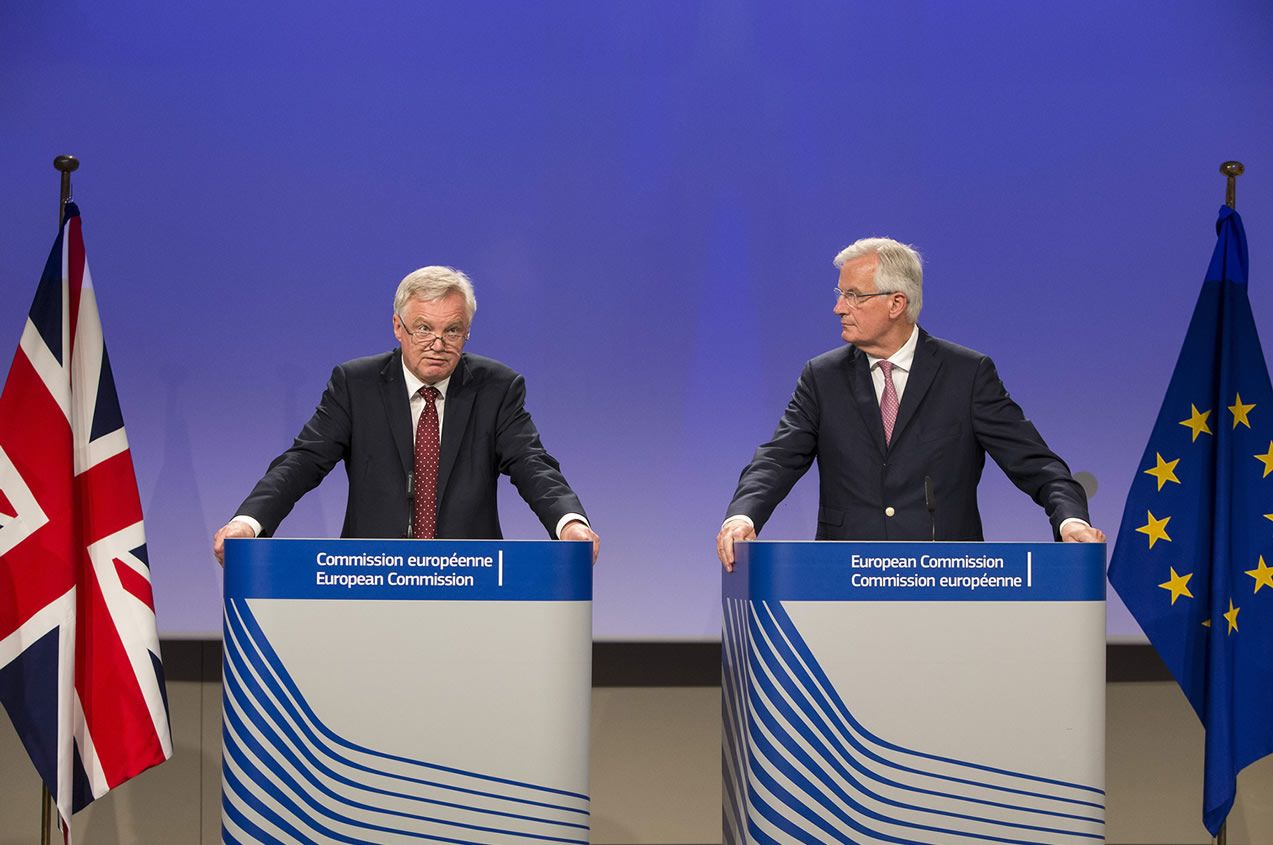Pound / Australian Dollar: Week-Ahead Technical Forecast, News and Data to Watch

The Pound to Australian Dollar exchange rate (GBP/AUD) appears to have found sound some support which hints that an established downtrend might be starting to fade.
GBP/AUD has maintained a steady move lower within the confines of an established downtrend until it reached a major trendline just over two weeks ago.

The trendline is likely to act as a tough obstacle against further declines and there is a possibility the pair may have reached a level where it could reverse and start a new trend higher, as it did in March 2017.
It is still too early to say whether it will reverse and go higher, but this is what we are looking for at present.
A lack of upside momentum is concerning for those holding out for a stronger Pound against the Aussie Dollar, as such we remain bearish on balance in the absence of more compelling bullish evidence, expecting an eventual erosion of the trendline and a break lower to occur.
As such, a move below the 1.6155 lows would probably confirm a break and a continuation of the downtrend to a target at the major psychological round-number level of 1.6000.
Get up to 5% more foreign exchange by using a specialist provider by getting closer to the real market rate and avoid the gaping spreads charged by your bank for international payments. Learn more here.
Data, News, and Events for the Australian Dollar
The main event for the Australian Dollar in the coming week is the meeting of the governing council of the Reserve bank of Australia (RBA) to set interest rates, at 5.30 BST on Tuesday, September 5.
The RBA is not expected to change interest rates from their current 1.5% level, although there are mutterings that the next move is more likely to be up than down.
Nevertheless, these amount to nothing and of the three major central bank meetings next week the RBA meeting is the least likely to result in a policy surprise.
"Unlike the ECB and BoC, the RBA is not ready to make changes. Monetary policy is accommodative enough and with their recent downgrades in GDP growth along with their concerns about their currency, they won’t be thinking about tightening either," said Kathy Lien of BK Asset Managment.
Indeed it appears that the RBA cannot move in either direction as extremely high household debt impugns them from raising rates and a housing bubble from cutting rates.
The other major release of the week is Q2 GDP which is expected to show a rise of 1.8% year-on-year (YoY) and 0.8% quarter-on-quarter (QoQ).
If the data comes out in line with expectations it will reflect an increase from Q1's 1.7% and 0.3% results, and help boost the Aussie.
Data for the Pound
On Monday, Construction PMI for August is out at 9.30 BST, and on Tuesday Services PMI at the same time.
PMI's are surveys of purchasing managers and provide a snapshot of how conditions are in a particular industry sector.
A score of over 50 indicates expansion and under 50 indicates contraction.
Construction is forecast to come out at 52.0 in August from 51.9 in July, and Services at 53.5 from 53.8 in July.
Markets will be looking for a repeat of Friday's Manufacturing PMI release which beat analyst expectations and hints that the UK economy might be picking up steam as we head into year-end. If correct, it should eleviate some of the persistent pressures on Sterling.
Thursday, September 7 witnesses the release of Halifax House prices in August at 8.30 BST.
Friday, September 8, sees the release of Industrial and Manufacturing Production for July, at 9.30 BST.
The former is supposed to show a 0.2% rise and the latter a 0.3% rise.
The Trade Balance in July is out at the same time, and is expected to show a narrowing of the deficit to -11.9bn from -12.72bn previously.
Politics: E.U. to "Educate" the U.K.

Image (C) European Commission.
While the data calendar hots up over coming days, politics will never be far away as a driver of Sterling.
Concerning headlines over the weekend have confirmed what many in the U.K. fear: the E.U. intends to make an example of the U.K. for its decision to exit the E.U. with chief negotiator Michel Barnier stating negotiations offer an opportunity for the E.U. to "teach the British people and others what leaving the EU means".
Barnier told a conference in Italy on the weekend that while he did not want to punish the U.K. for leaving he did confirm Brexit would serve as an "an educational process" for the British.
"I have a state of mind - not aggressive... but I'm not naïve," Barnier told the Ambrosetti forum. "There are extremely serious consequences of leaving the single market and it hasn't been explained to the British people. We intend to teach people… what leaving the single market means."
This confirms our view that the E.U. are in fact not in the mood for negotiating; rather they are placing a prescribed set of conditions down before the U.K. which must be accepted, or no deal will be granted.
Brexit negotiations have now passed three rounds, with some progress being made but the E.U. are keen to make it known that none of their initial objectives - particularly on receiving a payment of ~€100BN from the U.K. on its exit from the Union have yet been agreed.
Until the E.U. greenlight the first rounds concerning the technicalities of exit, they are not willing to discuss trade. This leaves Sterling prone to the risk that a disorderly exit takes place.
The big question we are however asking is whether or not Sterling fully reflects such a disorderly Brexit. If it does, then presumably the currency will become increasingly immune to negative newsflow concerning the negotiations. If not, then substantive downside must be negotiated.
Another question to ask, from a currency perspective, is how will dynamics change were the E.U. to be exposed as simply seeking to punish Britain, how does this impact on internal E.U. politics, particularly for countries such as Ireland and the Netherlands which rely heavily on their exports to the U.K?
German manufacturers also rely heavily on the U.K. market and one would expect a clash of economic interests and the political ideology as pushed by Barnier, Juncker and Verhofstadt.
Can pragmatism push the E.U. into a friendlier approach? If the answer is yes, it would certainly benefit Sterling.
Another question for those trying to anticipate the direction of politics and Sterling is to consider whether comments of "educating" the British sit well with the British people?
We saw how Theresa May found a rise in support on her robust response to Jean-Claude Juncker after he labelled her a difficult woman following a dinner in Downing Street. Voters tend to respond well to those defending them, and this might be the case should a seige mentality be established on the back of a daily barrage of warnings and threats from the E.U.
We would suggest that the Government's position on Brexit, and the Conservative Party by extension, might find some support were they to be seen as standing up to the E.U. and having a more flexible approach to negotiations.
And a more secure hand for the Conservative Party would play well for Sterling as a fragile Government makes for uncertainty, and the Pound hates uncertainty.
The prospect of five years without another uncertainty-inspiring vote will be welcomed.



